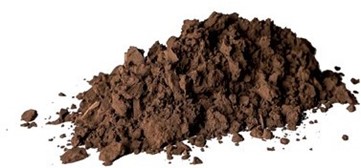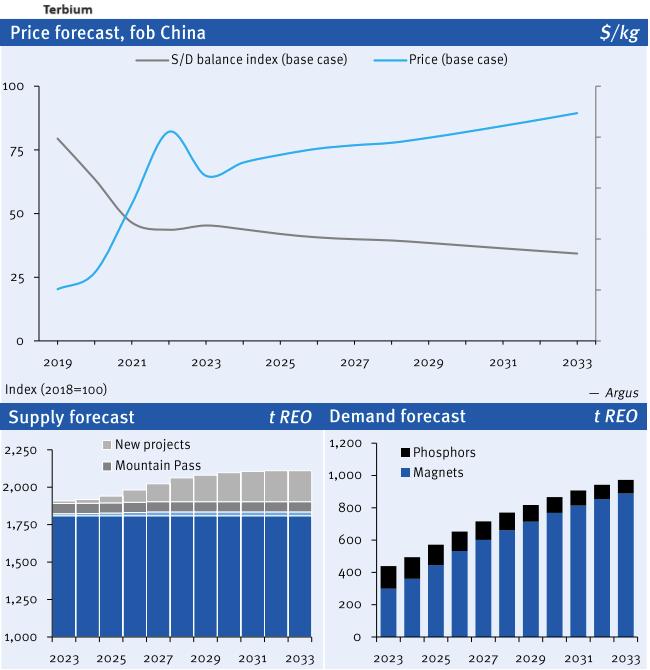Terbium Prices
The current price of Terbium is $1,983.40 per kg.
Please note that the price provided is the retail price for private investors and is aligned with industry retail pricing. For bulk purchases, whether investment or industry, please contact us directly for a quotation.
Table: Terbium Historical Prices and Price Changes
| Date | Terbium Price | Change % to Today | Annual Change % |
|---|---|---|---|
| Jul 11 2025 | $1,983.40 / kg | ||
| Jan 1 2025 | $1,396.50 / kg | +42.03% | |
| Jan 1 2024 | $2,197.70 / kg | –9.75% | -37.09% |
| Jan 1 2023 | $4,024.90 / kg | –50.72% | -45.40% |
| Jan 1 2022 | $3,306.00 / kg | –40.01% | +21.75% |
| Jan 1 2021 | $1,322.10 / kg | +50.02% | +150.06% |
| Jan 1 2020 | $668.01 / kg | +196.91% | +97.92% |
| Jan 1 2019 | $587.27 / kg | +237.73% | +13.75% |
| Jan 1 2018 | $581.28 / kg | +241.21% | +1.03% |
Terbium Historical Price Movement
At today’s price of $1,983.40 per kg, terbium changed +42.03% since the start of this year. This rare earth lost –9.75% in value since the start of last year and is down –50.72% since the start of 2023.
Since Jan 1st 2020 when the cost of terbium was $668.01 per kg it increased +196.91% in value. If we go back to Jan 1st 2018, when the price of terbium was $581.28 per kg, then the gain is .
Terbium is a chemical element with the symbol Tb and atomic number 65. In metal form, terbium is a silvery-white rare earth metal. In its oxide form, in which it is sold commercially, terbium is a black-brown powder.
Terbium does not occur naturally and is considered one of the “rarest” of Rare Earths.
To make an informed prediction on the future price of this rare resource, let’s first examine its varied applications and discover which countries are leading producers (alternatively, click here to jump to the terbium forecast).
Terbium Uses

Terbium is a rare earth element used in several different applications. For example, it’s a dopant in semiconductors, a phosphor in fluorescent lamps, and a colorant in glass. It is used in LCD screens, as it helps to create a bright, clear image.
Terbium is also used in lasers and optical fibers. In addition, it is often used in alloy steels and stainless steel, as it can help improve the metal’s strength and durability. Nuclear reactors sometimes use terbium, as its radioactivity can help to generate heat.
Terbium is also suitable for producing magnetic components, especially in neodymium-iron-boron magnets. Together with zircon dioxide, it’s indispensable in one of the most important industries of the future, namely as a stabilizer of high-temperature fuel cells.
As a result, terbium plays an essential role in a wide range of industries and technologies. In addition to its industrial uses, it’s also used in jewellery and as an investment commodity.
Where is Terbium Produced?
Terbium is never found in nature as a free element, but it’s contained in small amounts in minerals such as monazite, euxenite, and xenotime.
China currently mines more than 95 percent of the world’s terbium. The richest commercial sources of terbium at the moment are the ion-adsorption clays of southern China.
Other smaller mining areas are in the USA, India, Brazil, Sri Lanka, and Australia.

What Factors Determine the Price of Terbium?
Like any commodity, terbium’s price is determined by the law of supply and demand.
We have already established that terbium is a vital component in a wide range of industries and technologies. So, if the demand for LCD screens or lasers increases, the need for terbium grows too.
With China being the dominant supplier, China currently controls the supply of terbium. This means that the global supply is determined by how much China decides to export after they satisfy its own demand.
In addition, China has been using export quotas on rare earths as bargaining tools in their ongoing trade war with the US and Europe. And any restrictions on the terbium supply increase the price.
Terbium Price Forecast
Terbium, a cornerstone in high-tech innovations such as high-temperature fuel cells and permanent magnets, has witnessed extraordinary price movements in recent years. Between 2017 and 2022, terbium prices soared by an impressive 375%, outperforming all other rare earths. This meteoric rise was driven by booming demand for green technologies like electric vehicles and wind turbines. However, after such a prolonged rally, the market experienced a natural correction, with prices declining 45% in 2023 and a further 37% in 2024. These corrections appear to be temporary, as several factors point toward a potential rebound in the near future.
The Unique Supply Challenge of Terbium
Terbium is one of the rarer rare-earth elements, never found as a free element in nature and extracted painstakingly from minerals. Like other rare earths and technology metals, terbium’s production is inflexible; when demand rises, supply cannot rapidly adjust, leading to rigid and inelastic market conditions. This inflexibility means the demand for terbium can shift from calm to crisis, causing price spikes.
Moreover, terbium plays a critical role in manufacturing supply chains. A disruption in its availability could create a “single point of failure scenario,” where the absence of this element halts entire production lines. Manufacturers cannot afford such shutdowns, especially in industries like consumer electronics (e.g., iPhone production). When terbium prices spike, manufacturers absorb these costs and eventually pass them on to consumers. This dynamic underscores the essential nature of terbium in modern manufacturing and its vulnerability to supply shocks.
Geopolitical Influences and Supply Constraints
China dominates rare earths and terbium production, accounting for over 95% of the global supply, with its monopoly over refining and processing adding another layer of control.
With Donald Trump re-elected as US President, trade tensions between the US and China are expected to escalate further, leading to supply chain disruptions. Historical precedents, such as the 2010 rare earth embargo during a territorial dispute with Japan, highlight the risk of export restrictions. Recent moves by China, such as its export bans to the US on gallium and germanium in December 2024, suggest terbium could face similar constraints.
In fact, we didn’t have to wait long for geopolitical events to impact the market for terbium. Its price surged by 35% within a week of the tariff war between the US and China that started on April 2nd, 2025.
In addition, recent reports indicate that rare earth mining in Myanmar, a significant source of heavy rare earths like terbium, has halted due to geopolitical instability. Myanmar contributes approximately half of the world’s production of heavy rare earth elements. The cessation of mining activities there could lead to shortages and subsequent price increases for terbium.
Demand Dynamics and Market Outlook
Despite recent corrections, the demand for terbium is expected to remain robust, driven by its indispensable role in green technologies, electric vehicles, and wind turbines. Analysts from Fitch Ratings project that energy transition metals like terbium will see sustained demand through the 2040s as global low-emissions infrastructure continues to expand.
The current price correction may present an attractive opportunity for investors to acquire terbium at a lower cost ahead of a potential rebound. Terbium’s unique market dynamics, characterized by its scarcity, inelastic supply, and critical applications, highlight its potential for substantial long-term returns. While prices may fluctuate in the short term, the strategic importance of terbium positions it as a valuable asset in an increasingly electrified and technologically driven world.
The 10-year forecast graphs below, by Argus Media, show terbium’s future price (fob China), demand, and supply estimates.

How and Where to Buy Terbium
Commercial-grade terbium is usually sold and bought in its oxide (powdered) form, as in the right conditions, oxides can be stored almost indefinitely.
While it’s possible to buy small amounts of terbium at online marketplaces like eBay, Alibaba, and Amazon, corporate buyers like Ford, Honda, and LG only use reputable metals dealers. Globally licensed market metals dealers, such as ourselves, act as key intermediaries between the high-tech industries and the miners & producers of the necessary rare earths and strategic metals for these industries.
We provide the full chain of custody, guaranteeing the quality and purity (min. 99.99%) of the terbium they buy. Our storage facility also offers the right industrial conditions for storage, meaning any discerning investors who want to benefit from future terbium price raises by purchasing and owning some terbium can do so safely through us.
Terbium futures contracts can also be traded in the Shanghai Metal Market (SMM).
How and Where to Sell Terbium
The only serious end buyers for your industrial-grade terbium are companies such as Sony, Tesla, General Motors, and BMW. These companies will only purchase from reputable industry suppliers who can provide the complete chain of custody, analysis reports, and appropriate storage facilities.
Places like Alibaba, eBay, and Amazon only attract hobbyists. Only because we are an industry supplier can we guarantee the safe and fast liquidation of the rare earth metals of our investors at market rates.
All prices on this page last updated Jul 11 2025.


